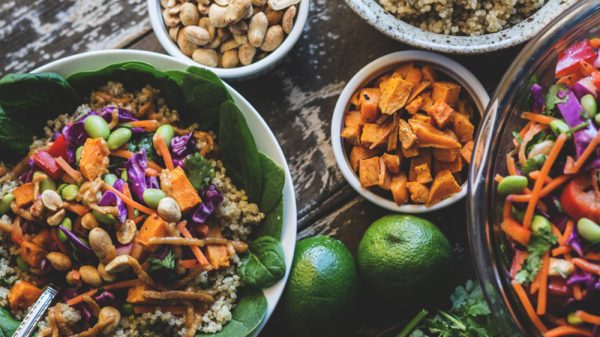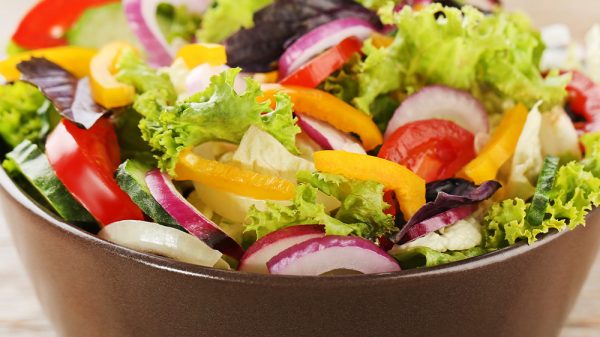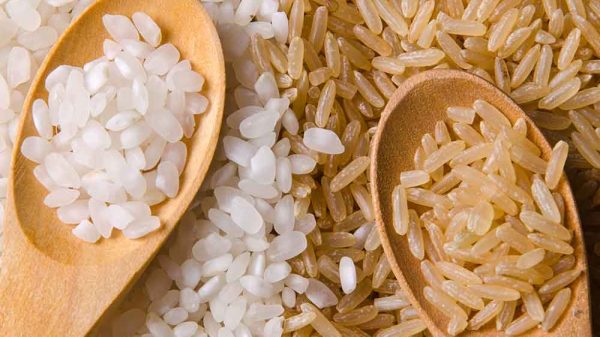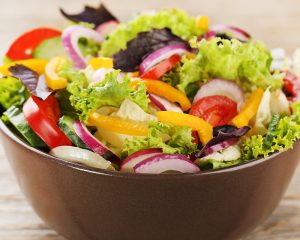A summer party isn’t complete without a tray of raw veggies and ranch dip. Plus, raw food diets are popular due to claims of being nutritionally superior and higher in nutrients and natural enzymes. There’s no doubt that raw veggies are delicious and satisfying, but should we be eating all vegetables raw? Not necessarily. In fact, it may be best to avoid eating certain vegetables raw.
Keep reading to find out information about how to eat your vegetables, including which vegetables should be eaten raw and which vegetables should not be eaten raw.
Vegetables You Can Eat Raw
Let’s first take a look at vegetables you can eat raw and may hold even more nutritional value when eaten raw.
1. Bell Peppers
Bell peppers come in vibrant colors like red, yellow, orange, and green and are commonly incorporated into cooked dishes. But did you know that bell peppers retain more of their nutrients when they are consumed raw? Try slicing a variety of bell peppers into long strips. Serve with hummus or Greek yogurt dip for a snack that’s packed with vitamin C, fiber, and protein!
2. Kale
Kale is a cruciferous vegetable that can be eaten raw. This leafy green veggie is packed with polyphenols with antioxidant properties, as well as vitamin C and vitamin K. Kale even contains calcium, magnesium, and protein!
Kale can sometimes be tricky to eat raw because of its curly texture. Looking for a way to make raw kale more appealing? Cut it into small pieces and marinate in lemon juice and olive oil. The acid from the lemon helps soften the kale to make it a little more palatable and easy to add to your favorite savory dishes.
3. Broccoli
Broccoli is packed with vitamin C and fiber, as well as a sulforaphane antioxidant and cancer-fighting compound known as lutein. Research shows that sulforaphane compounds may play a role in fighting against malignant cells and decreasing the risk of developing cancer. (1) Enjoy broccoli chopped up and added to your salads or dipped in your favorite sauce.
4. Cauliflower
Cauliflower is satisfyingly crunchy when eaten raw and contains healthy compounds like vitamin C and vitamin B6. When comparing broccoli vs cauliflower, they are both cruciferous vegetables with a similarly mild taste and nutritional benefits, though they do have different textures. Enjoy raw cauliflower by cutting it into bite-size pieces and dipping it in your favorite dressing or sprinkling it on top of salads.
5. Beets
Beets are packed with nutrients like vitamin C, potassium, and antioxidants known as betalains. Beets are also filled with natural nitrates that help increase blood flow. To prepare beets raw, try slicing them thinly, marinating them, and adding them to salads. Alternatively, try blending frozen beets into smoothies and shakes.
Vegetables You Should Cook
When it comes to which vegetables should not be eaten raw, it’s important to consider nutrient content and the impact on the digestive system.
1. Potatoes
Can you eat raw potatoes? What about sweet potatoes? Can you eat sweet potatoes raw? Eating raw potatoes is not appealing from a flavor perspective. Plus, raw potatoes contain lectins, which are small plant compounds that can irritate the digestive system. Both raw white potatoes and sweet potatoes are also packed with starches that are challenging to break down, but in general, they are edible. You probably just want to limit the amount of raw potato that you consume, and overall, it’s much healthier and easier on the digestive system to stick to cooked potatoes.
What you do want to avoid are raw potatoes that have turned green. The green color is indicative of a harmful compound called solanine, which is a type of glycoalkaloid that is poisonous to humans. Regardless of whether you cook green potatoes, the solanine will still have harmful effects.
2. Asparagus
Most of us are used to eating asparagus sauteed or baked. Cooked asparagus provides the most health benefits. Can you eat asparagus raw, if you wanted to? Contrary to popular belief, you can consume asparagus raw. Asparagus tips are the most palatable part of the plant when eaten raw, and they are easier to chew when thinly sliced.
3. Carrots
Carrots are more nutritious if they’ve been subjected to heat. Steaming or roasting carrots helps to break down cell walls, which normally trap nutrients inside and are challenging for the digestive system to break down. However, even though more nutrients may be released when cooked, you can keep those raw carrots on your vegetable platter.
4. Rhubarb
Rhubarb stalks look like a pink version of celery. Though they can be eaten raw, they can be very bitter tasting. Rhubarb is most often eaten when stewed with sweeteners until soft and milder in flavor. Rhubarb leaves, on the other hand, get a bad rap for being filled with harmful compounds called oxalates or oxalic acid. However, the jury is still out on whether eating rhubarb leaves is actually harmful. Oxalates in high concentrations are known to cause kidney issues, such as kidney stones. Oxalates are also known as anti-nutrients because they may inhibit the absorption of calcium.
Some argue that many different veggies contain oxalates, and as long as you avoid consuming oxalate-containing foods in absurdly high amounts, oxalates are harmless. Always check with your doctor or a registered dietitian if you are concerned about certain compounds in food.
5. Mushrooms
The cooking process shrinks mushrooms down and makes it easier to eat a large serving. These healthy, edible fungi are filled with nutrients like B vitamins and zinc, as well as lesser-known compounds called beta-glucans. Beta-glucans are particularly helpful for healing and boosting the immune system.
Can you eat mushrooms raw? Some are concerned about the presence of a certain toxin called agaritine in mushrooms. However, agaritine seems to be present only in small amounts and degrades over time after picking. Cooking also helps get rid of agaritine. The bottom line is, however, that eating mushrooms from the grocery store is not harmful. Just avoid wild mushrooms since a trained expert needs to distinguish between the kinds that are poisonous and the kinds that are safe to eat.
6. Eggplant
Eggplant can taste a little bitter and unappealing if uncooked, and the skin can be tough and hard to digest. Generally, eggplant is much more palatable and easy to eat if cooked. Try roasting the eggplant in the oven with a little olive oil, garlic, salt, and pepper for a hearty side dish that’s filled with fiber, B vitamins, and vitamin C.
Tips for Choosing Vegetables to Eat Raw or Cooked
The majority of vegetables can be eaten either raw or cooked. It just depends on your personal preference. If you need some guidance, here are a few rules of thumb that are helpful for choosing how you want to prepare your vegetables.
1. Consider How You Feel
Not all vegetables work for everyone. For some, certain vegetables may cause bloating and gastrointestinal discomfort, while for others, the same vegetables are digested just fine. For example, if you find that you have a stomach ache after every meal that includes raw zucchini, try cooking it next time. Chances are, you won’t experience the same stomach ache.
Why are raw vegetables more likely to cause digestive problems? Veggies are packed with loads of insoluble fiber that pass through the digestive system pretty much intact. The uncooked starches in veggies can irritate the lining of the stomach and cause bloating and cramping.
2. Beta Carotene Content
Beta carotene is a type of antioxidant called a carotenoid and is present in tons of orange and yellow fruits and veggies. Vegetables that contain beta carotene are technically healthier when they are cooked since the cooking process releases more of the antioxidant and makes it bioavailable.
3. Lycopene Content
Lycopene is another type of carotenoid that becomes more bioavailable during the cooking process. Tomatoes are rich in lycopene and tend to be richer in nutrients when roasted or turned into a sauce.
4. Cruciferous Vegetables
Most cruciferous vegetables like broccoli, kale, cauliflower, and cabbage can be eaten raw. Brussels sprouts are cruciferous vegetables that can also be eaten raw, but they tend to be a little tougher than the other cruciferous veggies. You may want to eat a smaller quantity of raw brussels sprouts to avoid stomach discomfort or gently roast them.
5. Taste
No one wants to eat vegetables if they don’t taste good, and if you’re not eating vegetables, you won’t glean their health benefits. To increase the probability of eating more vegetables, prepare them in your favorite way – either cooked or raw.
Meal Ideas for Including Lots of Veggies in Your Diet
At the end of the day, deciding to eat your vegetables raw or cooked doesn’t make a dramatic difference for your health. Simply eating vegetables in your daily diet is what matters most. But how can you make sure that you’re getting plenty of vegetables on a daily basis? Check out these tips for making tasty vegetable-based dishes that you can include in your breakfast, lunch, and dinner.
Vegetable Scramble
Preparing a savory vegetable scramble is the perfect way to fit lots of vegetables into your diet early in the day. Plus, eggs are filled with complete protein that offers optimal ratios of essential amino acids. Saute or steam onions, garlic, bell peppers, spinach, and mushrooms in a pan. Pour in two egg whites and one egg yolk. Season with salt, pepper, and red pepper flakes.
Chopped Salad
Salads don’t have to be boring and unsatisfying! Create your salad base using your favorite chopped greens, such as kale and spinach. Load up your salad with raw and grilled veggies, like carrots, bell peppers, eggplant, cauliflower, and any other vegetables you like. For protein and crunch, sprinkle with your favorite beans like red kidney beans, chickpeas, or black beans, as well as pumpkin seeds. Drizzle with your favorite dressing and enjoy for lunch or dinner.
Veggie Stir-Fry
Vegetable stir-fry is an easy and fast way to fit tons of vegetables into one meal. Simply toss your favorite vegetables in a pan and saute with olive oil or your favorite sauce until fragrant and soft. Enjoy the veggies with a protein like salmon or chicken breast and whole-grains for a well-balanced meal.
Why Are Veggies Important, Anyways?
Including vegetables in your daily diet is important for boosting your daily intake of fiber, vitamins, minerals, and antioxidants. For an individual who eats vegetables, the daily intake of micronutrients is substantially higher than for individuals who don’t eat these vegetables.
Fiber supports a healthy gut microbiome by feeding the good bacteria in your digestive system. As these good bacteria feed on fiber, they produce anti-inflammatory compounds as byproducts, which are absorbed through the intestinal walls and into the bloodstream. As the compounds travel through the bloodstream and reach different tissues and organs, they help lower systemic inflammation.
Vitamins, minerals, and antioxidants help the cells throughout the body function more effectively. Antioxidants play a special role in reducing oxidative stress, which occurs in response to stress, eating unhealthy foods, inhaling chemicals, or being exposed to other damaging particles. Oxidative stress is a major contributor to a host of non-communicable diseases.
Because of how micronutrients in vegetables can fight against oxidative stress and inflammation, they are protective against certain diseases. People who eat more vegetables and less processed foods, animal products, and added sugar tend to be at a lower risk for conditions like fatty liver disease, type 2 diabetes, high blood pressure, heart disease, and certain cancers.
The healing compounds in vegetables help encourage healthy metabolic function and help you maintain a healthy weight. The fiber in vegetables can also help facilitate weight loss. Veggies are bulky, fiber-rich foods that are low in calories. So, you can fill up on vegetables while consuming relatively few calories.
Conclusion: Which Vegetables Can Be Eaten Raw and Which Vegetables You Should Not Be Eaten Raw
Veggies are a healthy part of a balanced diet that also includes protein and healthy fats. Most vegetables are safe to eat raw, although cooking them may release more nutritional compounds. Cooked vegetables may also be easier on the stomach and cause fewer digestive issues. Either way, vegetables are chock-full of health-promoting nutrients and help prevent and reverse non-communicable diseases.
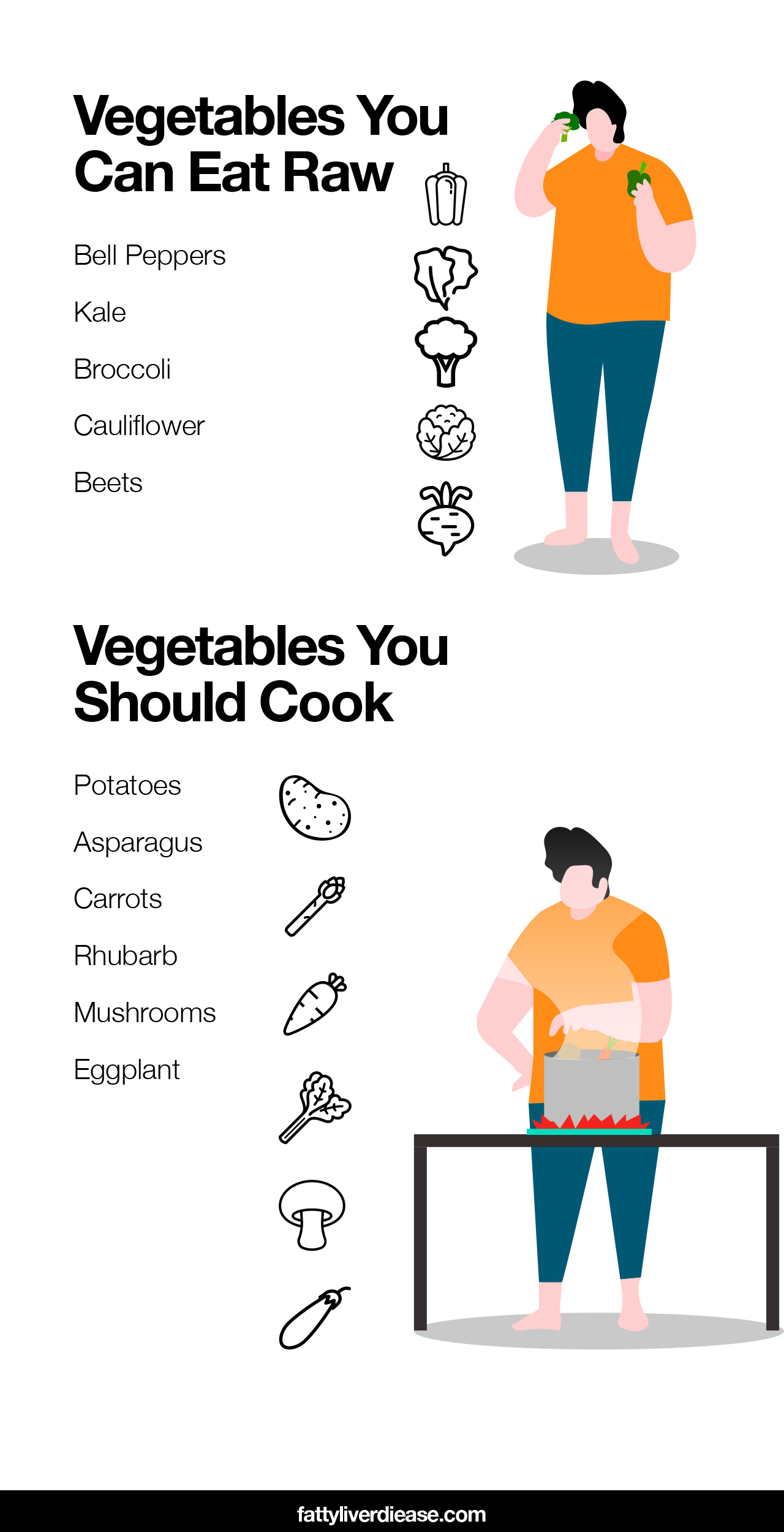
References:

